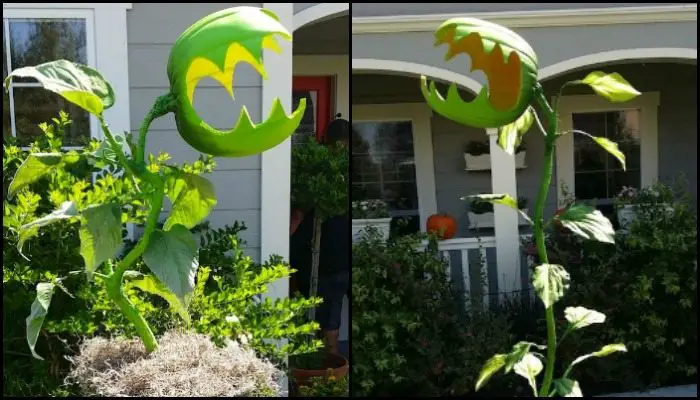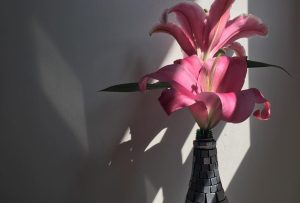It’s the season for growing man-eating monster plants!
OK – so these plants may not be real but they are definitely the perfect plants to put in your pots for the Halloween! The more wild and menacing they look, the more fun it is for everyone who loves Halloween.
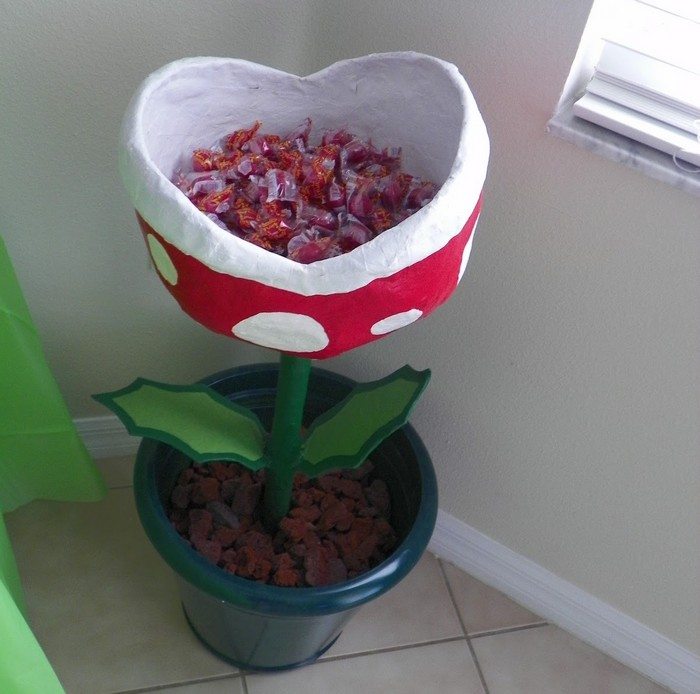
It’s very easy to make and only takes about two hours to finish.
We also like that it is inexpensive since you recycle or repurpose the materials for it. You can use a chipped or cracked flower pot, and it would in fact look better that way! You can also use old toys to decorate it.
The stem used for this project is a simple tree branch that you can easily find in your yard or a park nearby. The thicker the branch, the better, because it will give the monster plant a really poisonous look.
Let your imagination run wild and design your very own man-eating monster plants! You can make several at various heights to make your Halloween garden decor look better!
Need inspiration? Check our gallery of monster plants below!
Is this going to be your next Halloween project?
Contents
Crafting a Man-Eating Monster Plant Decoration
Materials
- Tree Branch
- Flower Pot
- Spray Foam Insulation
- Artificial Pumpkin
- Green Spray Paint or Brush-on Paint
- Faux Leaves
- Decorative Items (Moss, Skeletons, Spiders, Bones, etc.)
Tools
- Hot Glue Gun
- Pumpkin Carver
Instructions
Prepare the Flower Pot:
- Start by cleaning your flower pot. If you’re using an old, cracked one, great! It adds to the spooky effect. Make sure it’s sturdy enough to hold the branch and foam.
Insert the Tree Branch:
- Place the tree branch in the center of the pot. Ensure it’s firmly positioned and balanced. You may need to adjust the base or add weight (e.g., rocks or soil) to keep it steady.
Apply Spray Foam Insulation:
- Use the spray foam insulation around the base of the branch to fill the pot. Spray generously to cover the pot’s interior and form a stable base. Let the foam expand and harden according to the manufacturer’s instructions. This will take a few minutes to an hour.
Prepare the Artificial Pumpkin:
- Using the pumpkin carver, cut a large, jagged opening on one side of the pumpkin to create the mouth of the monster plant. Feel free to get creative with sharp teeth and a menacing shape.
Attach the Pumpkin to the Branch:
- Once the foam is set, attach the artificial pumpkin to the top of the branch. Use the hot glue gun to secure it in place. Ensure it’s firmly attached, with the mouth facing outward for the best visual effect.
Add Details to the Pumpkin:
- Paint the pumpkin and branch with green paint to give your plant a monstrous, venomous look. Use brush-on paint for detailed areas and spray paint for broader coverage. Let the paint dry completely.
Add Faux Leaves and Foliage:
- Glue faux leaves around the base of the pumpkin and along the branch to simulate plant foliage. You can also add leaves inside the pumpkin’s mouth for a more overgrown appearance.
Decorate with Spooky Items:
- Enhance your monster plant with decorative items. Glue moss, skeletons, spiders, and bones around the pot, branch, and pumpkin to create a creepy, haunted look.
Final Touches:
- Step back and review your creation. Adjust any elements as needed and add more decorative items if desired. Ensure everything is securely attached and visually balanced.
Display Your Monster Plant:
- Place your man-eating monster plant in a prominent spot in your garden. Consider adding additional lighting or fog effects to make it even more dramatic at night.
Click on any image to start lightbox display. Use your Esc key to close the lightbox. ![]()
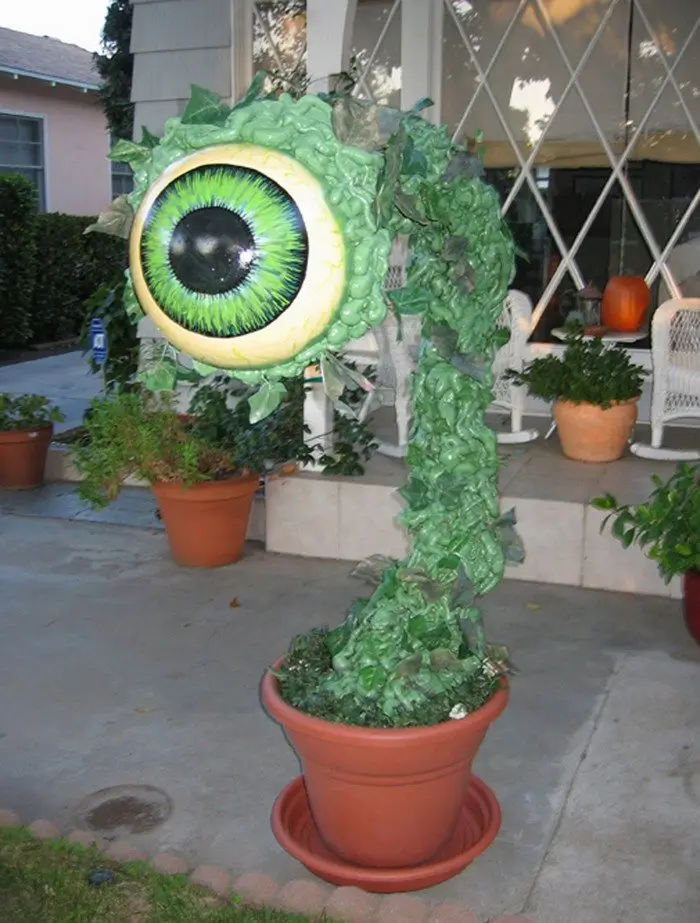
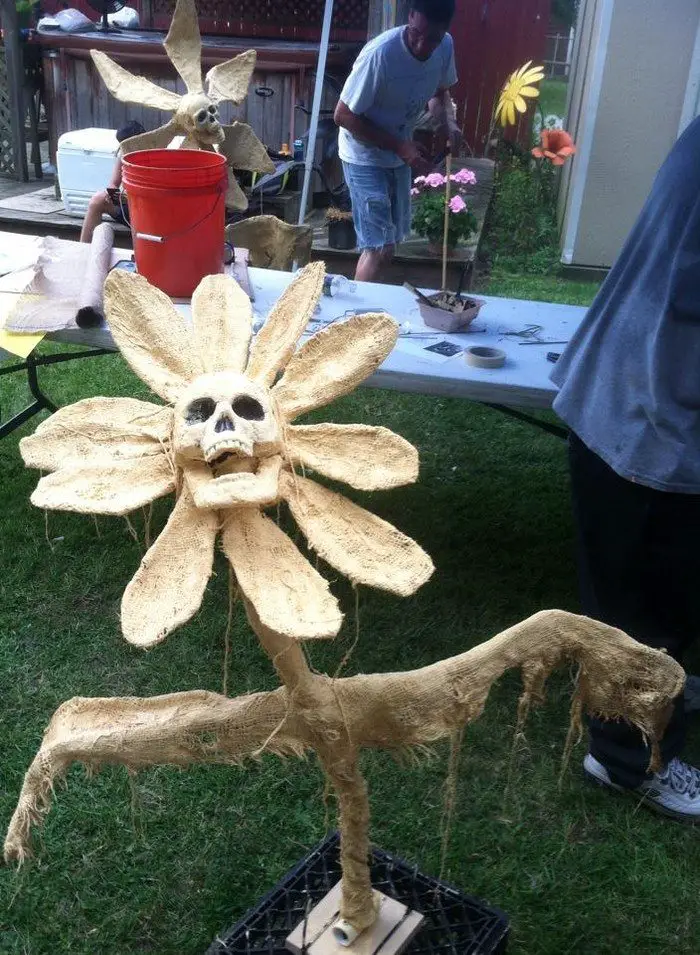
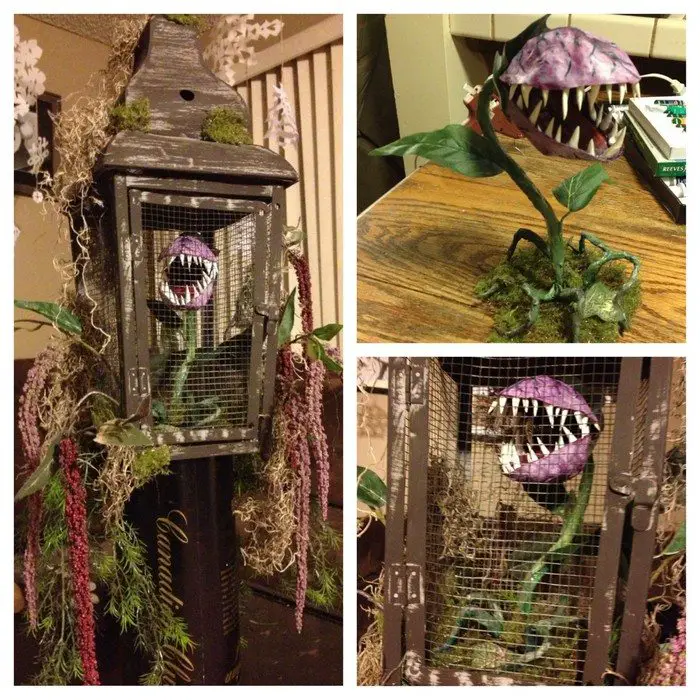
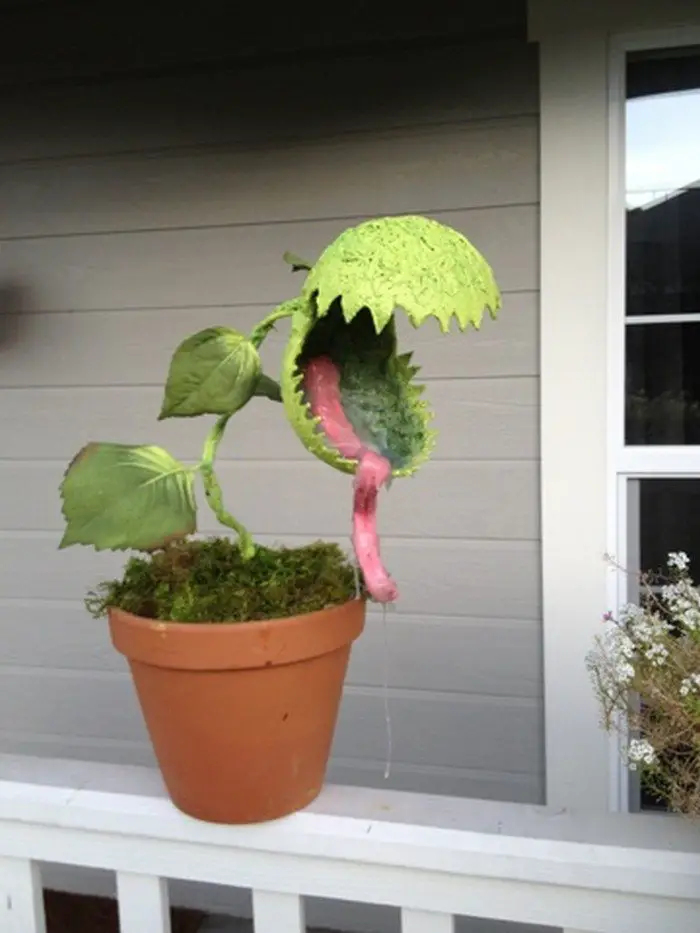


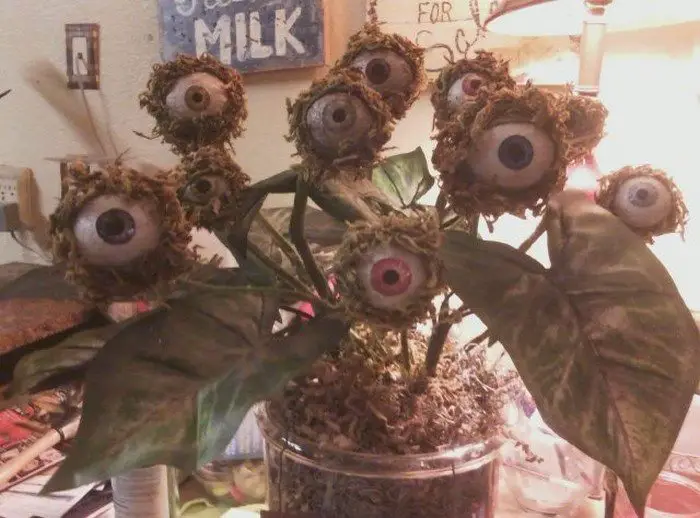





You can get more step-by-step instructions here…
DIY Customization Ideas for Man-Eating Monster Plants
Creating a man-eating monster plant for Halloween is an exciting project that allows you to bring a touch of the fantastical into your garden decor. Drawing inspiration from popular media and video games, you can customize your man-eating monster plant to resemble some of the most iconic and terrifying plants. Here are some creative ideas to help you design a man-eating monster plant that will be the star of your Halloween display.
1. Venus Flytrap: Inspired by “Little Shop of Horrors”
The infamous man-eating plant, Audrey II, from the musical “Little Shop of Horrors,” is a perfect inspiration for your project.
- Customization Tips:
- Use a large, open-mouthed artificial flower or pumpkin to mimic Audrey II’s gaping maw.
- Paint the insides with a vibrant red or pink and add sharp, tooth-like edges.
- Incorporate thick, vine-like branches and broad leaves to replicate its menacing appearance.
2. Piranha Plant: Straight from the “Mario” Universe
The Piranha Plant from the “Mario” video games is a classic choice for a man-eating monster plant.
- Customization Tips:
- Choose a bright red color for the head of your plant, with white spots to match the iconic look.
- Create long, jagged teeth and a gaping mouth that snaps shut.
- Use green paint for the stem and leaves, adding a leafy base that looks like it could be hiding more danger.
3. Carnivorous Plant: Modeled after the “Harry Potter” Mandrakes
Though not exactly man-eating, the Mandrakes from “Harry Potter” provide an eerie and magical inspiration.
- Customization Tips:
- Sculpt or carve the face of your plant with a distressed or screaming expression.
- Use earthy tones and paint roots or vines around the pot to mimic the Mandrake’s natural look.
- Add a few realistic details like small hands or branches reaching out.
4. Mutant Plants: Inspired by “Resident Evil” Games
The mutated plants from the “Resident Evil” series offer a darker, more grotesque take on man-eating monster plants.
- Customization Tips:
- Opt for twisted, gnarled branches and dark, mottled colors.
- Add tentacle-like vines or oversized leaves with sharp edges.
- Use artificial blood or red paint to give a menacing, carnivorous appearance.
5. Poison Ivy’s Plants: From the “Batman” Comics
Inspired by the botanical villain Poison Ivy, these man-eating monster plants are both beautiful and deadly.
- Customization Tips:
- Use lush, verdant foliage and deep green tones for the leaves and vines.
- Incorporate flowers with sharp thorns or tendrils that appear ready to ensnare.
- Add an alluring yet dangerous look with bioluminescent paint or glowing accents.
6. Plants from “The Last of Us”
While not exactly man-eating, the cordyceps-infected flora from “The Last of Us” create a terrifying post-apocalyptic feel.
- Customization Tips:
- Use dark, spore-covered materials to replicate the fungal growth seen in the game.
- Paint the branches and pot in sickly, mottled colors to mimic the infected environment.
- Add twisted roots and scattered bones to enhance the eerie effect.
7. The Demogorgon Plant: Inspired by “Stranger Things”
Channel the monstrous flora from the “Upside Down” in “Stranger Things” to create a truly terrifying man-eating monster plant.
- Customization Tips:
- Sculpt a gaping, flower-like mouth with sharp teeth, mimicking the Demogorgon’s terrifying visage.
- Paint in dark, shadowy colors with hints of deep red to capture the look of the Upside Down.
- Add tendrils and creeping vines to give the appearance that it’s ready to reach out and snatch its prey.
With these customization ideas, your man-eating monster plant can be as unique and horrifying as you imagine. Whether you’re drawing from the colorful world of video games or the eerie scenes of your favorite movies, each plant can become a centerpiece of your Halloween garden. Don’t be afraid to mix elements from different inspirations to create a truly one-of-a-kind man-eating monster plant.
Safety Tips for Halloween Decorations
When decorating your garden for Halloween, safety should be a top priority. This is especially important when you’re creating impressive displays like a man-eating monster plant. Here are some crucial tips to keep your decorations safe and secure.
Use flame-resistant materials for all your Halloween decorations, including the components of your man-eating monster plant, to reduce fire risks. Make sure heavy decorations are properly anchored to prevent them from tipping over or causing injuries. Keep walkways clear of obstructions. Avoid placing decorations where they could cause someone to trip or block exits in case of an emergency.
Opt for battery-powered lights instead of open flames or traditional electric lights. This is particularly important around flammable materials. Always check electrical cords and lights for any signs of wear and tear. Use outdoor-rated extension cords and avoid overloading electrical circuits.
Ensure that all decorations, especially those with branches or stems, have smooth edges to prevent cuts or injuries. Keep an eye on children and pets around your Halloween setup. Small parts or fragile materials can pose a choking hazard or could be accidentally ingested.
Weather-proof your decorations based on your local conditions. Secure outdoor items against wind and rain to prevent them from becoming hazardous. Use non-toxic paints and adhesives for your projects to avoid harmful fumes or skin irritation.
Finally, properly dispose of any leftover or damaged materials. This helps prevent environmental hazards and keeps your garden safe for everyone.
Conclusion
Creating a man-eating monster plant decoration is a fun and imaginative way to enhance your Halloween decor. With a few simple materials and a bit of creativity, you can transform your garden into a spooky spectacle. Get ready to impress and delight everyone who visits your haunted setup this Halloween!

